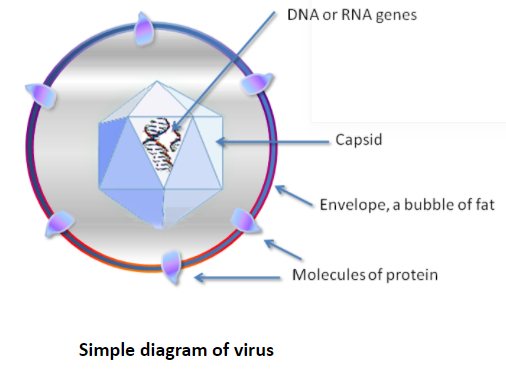Answer
392.1k+ views
Hint: Outside the host cell virus behaves like matter. Only upon finding a living host organism, it injects its DNA/RNA to propagate its genes.
Complete answer: Virus is an infectious agent and quite small.
It injects its genetic material into the host and replicates within the living cells of the host.
A virus is made up of just genetic material, be it DNA or RNA.
The genetic material is covered by a protein-made capsule, often called a capsid.
The virus first attaches to the surface of bacteria.
It occurs by random encounters; then it injects genetic material through the host cell membrane.
The protein coat remains outside of the host cell.
After injecting viral DNA, the normal mode of replication and transcription does not occur in the host cell.
Rather, the host cell now produces viral DNA and its proteins.
Hence, it has no cell and metabolic activity and it cannot reproduce on its own.

So, the correct option is D. All of the above.
Note: The entire virus is called a virion and it consists of both the outer capsid shell and the inner nucleic acid component. The capsid provides specificity of the virus while the nucleic acid is the cause of its infectivity.
Complete answer: Virus is an infectious agent and quite small.
It injects its genetic material into the host and replicates within the living cells of the host.
A virus is made up of just genetic material, be it DNA or RNA.
The genetic material is covered by a protein-made capsule, often called a capsid.
The virus first attaches to the surface of bacteria.
It occurs by random encounters; then it injects genetic material through the host cell membrane.
The protein coat remains outside of the host cell.
After injecting viral DNA, the normal mode of replication and transcription does not occur in the host cell.
Rather, the host cell now produces viral DNA and its proteins.
Hence, it has no cell and metabolic activity and it cannot reproduce on its own.

So, the correct option is D. All of the above.
Note: The entire virus is called a virion and it consists of both the outer capsid shell and the inner nucleic acid component. The capsid provides specificity of the virus while the nucleic acid is the cause of its infectivity.
Recently Updated Pages
How do you arrange NH4 + BF3 H2O C2H2 in increasing class 11 chemistry CBSE

Is H mCT and q mCT the same thing If so which is more class 11 chemistry CBSE

What are the possible quantum number for the last outermost class 11 chemistry CBSE

Is C2 paramagnetic or diamagnetic class 11 chemistry CBSE

What happens when entropy reaches maximum class 11 chemistry JEE_Main

Calculate the volume occupied by 88 gram of CO2 at class 11 chemistry CBSE

Trending doubts
Difference between Prokaryotic cell and Eukaryotic class 11 biology CBSE

Difference Between Plant Cell and Animal Cell

What organs are located on the left side of your body class 11 biology CBSE

List some examples of Rabi and Kharif crops class 8 biology CBSE

Give 10 examples for herbs , shrubs , climbers , creepers

The vapour pressure of a given liquid will decrease class 11 chemistry CBSE

An aqueous solution of urea containing 18 g urea in class 11 chemistry CBSE

Proton was discovered by A Thomson B Rutherford C Chadwick class 11 chemistry CBSE

Write two differences between autotrophic and heterotrophic class 10 biology CBSE



